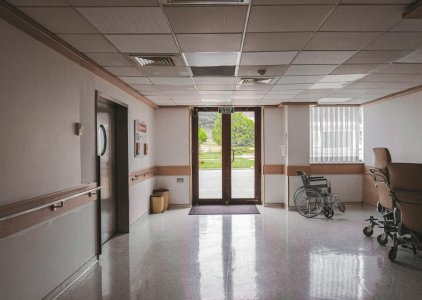A major health care change is coming—here’s why rural hospitals are sounding the alarm
By
Veronica E.
- Replies 0
If you depend on your local hospital for care—or simply want to keep your community’s health care strong—there’s a change in federal law that may affect you in the coming years.
A newly passed law aims to restructure how states fund hospitals that treat low-income patients, including many seniors, children, and those with disabilities.
While the change won’t take full effect until 2028, health leaders in small towns and rural communities are already raising red flags.
For hospitals that rely heavily on government support to stay open, the financial shift could mean reduced services—or closures.
Here’s what’s changing, and why some say it could have life-or-death consequences for America’s rural health system.

What is changing and why it matters
At the center of the debate is Medicaid, the joint federal and state program that helps cover health care for low-income Americans.
It serves nearly 90 million people, including many in rural communities.
But Medicaid typically pays hospitals and doctors less than the actual cost of delivering care.
To help fill the gap, states have long been allowed to make “extra” payments to hospitals, helping them stay financially viable—especially when they serve a large number of Medicaid patients.
These extra payments have grown significantly in recent years, rising to over $110 billion in 2024, a 60% increase from the year before.
Lawmakers behind the new legislation say the current structure has become unsustainable and contributes to federal overspending.
Also read: Could changes to Medicaid funding put your local hospital in danger?
How the new law limits Medicaid payments
Under the new policy—part of the One Big Beautiful Bill Act signed by President Donald Trump—states will be required to gradually reduce their Medicaid supplemental payments starting in 2028.
Each year, reimbursement rates will be lowered by 10 percentage points until they are capped at 100% to 110% of Medicare rates, depending on whether a state expanded Medicaid under the Affordable Care Act.
The Congressional Budget Office projects the change will reduce Medicaid spending by $149 billion over the next decade.
While that may sound like good news for the federal budget, it’s raising concerns among hospital administrators about how communities will be affected.
Also read: Nearly 1.8 million Texans have lost Medicaid coverage—here’s what that means for health care access
Rural hospitals already struggling to survive
For many rural hospitals, these extra Medicaid payments are a financial lifeline.
Without them, some say they won’t be able to keep their doors open.
In Kansas, 87% of rural hospitals are operating at a loss. “Many hospitals in our state are at risk of closure,” said Cindy Samuelson of the Kansas Hospital Association.
Across the country, hundreds of rural hospitals have already cut services like obstetrics and chemotherapy in response to ongoing budget pressures.
In many areas, the next closest hospital may be an hour or more away—making emergency care and maternal health even more difficult to access.
Benjamin Anderson, CEO of Hutchinson Regional Health System in Kansas, warned that removing the current safety net would put the entire community at risk.
“In a rural community, we all get care in the same place,” he said.
Also read: Medicaid rollbacks could quietly affect your housing and food support—what to know
Why it affects more than just Medicaid patients
The impact of hospital closures or service cuts doesn’t stop with Medicaid recipients.
When a hospital scales back its services, everyone in the area—including those with Medicare or private insurance—may face longer travel times, reduced access to care, and lost local jobs.
Businesses considering a move to the area may think twice if there’s no nearby emergency room or maternity ward.
A reduction in hospital funding also hurts local economies, which often rely on health care as a major employer.
In small towns, the local hospital is often one of the largest—and most stable—sources of employment.
Also read: You won’t believe what happened to seniors in wheelchairs at a Medicaid protest—Capitol Police involved
Supporters argue it’s about reducing wasteful spending
Those in favor of the law say the current Medicaid payment structure has become bloated and inefficient.
The Paragon Health Institute, a conservative think tank, argues that some payments benefit “special interests” rather than patients, and that trimming excess spending is necessary to control the federal deficit and inflation.
Hospital leaders disagree, saying Medicaid already pays only about two-thirds of what it actually costs to treat patients.
Without supplemental payments, they say many hospitals will be forced to choose between cutting services or closing altogether.
Also read: Transform your home into a personal hospital room—discover how hospitals are cutting crowds and bringing care to you!
A new fund offers limited relief
To soften the blow, the new law includes a $50 billion Rural Health Transformation Program, which will provide targeted support to the most vulnerable hospitals.
States like Kansas and Mississippi are expected to receive hundreds of millions in relief funding between 2026 and 2030.
But the funding is not guaranteed to reach every hospital.
Richard Roberson of the Mississippi Hospital Association emphasized the need for sustainable, long-term support.
“We want to make sure we’re working with the state to provide sustainable solutions, not one-time fixes,” he said.
Also read: What one knee surgery might cost you—$12,000 or $100,000?
What you can do now
Even if you don’t use Medicaid, your hospital’s financial health could affect your care in the future.
Here are a few steps you can take:
Health care is about more than numbers—it’s about real people, real hospitals, and real communities.
Let’s keep the conversation going and support solutions that help everyone stay cared for and connected.
Read next: At 80, he’s still working—just to pay his late wife’s $80,000 hospital debt

Have you noticed changes at your local hospital? Are you worried about how these funding changes could affect your care or the care of someone you love? Or do you think these cuts are necessary to protect the national budget?
Join the conversation in the comments below. At The GrayVine, we believe every voice matters—especially when it comes to health care access in communities across the country.
A newly passed law aims to restructure how states fund hospitals that treat low-income patients, including many seniors, children, and those with disabilities.
While the change won’t take full effect until 2028, health leaders in small towns and rural communities are already raising red flags.
For hospitals that rely heavily on government support to stay open, the financial shift could mean reduced services—or closures.
Here’s what’s changing, and why some say it could have life-or-death consequences for America’s rural health system.

Small-town hospitals across the US are facing uncertainty as new federal health care policies begin to take shape. Image Source: Pexels / Zakir Rushanly.
At the center of the debate is Medicaid, the joint federal and state program that helps cover health care for low-income Americans.
It serves nearly 90 million people, including many in rural communities.
But Medicaid typically pays hospitals and doctors less than the actual cost of delivering care.
To help fill the gap, states have long been allowed to make “extra” payments to hospitals, helping them stay financially viable—especially when they serve a large number of Medicaid patients.
These extra payments have grown significantly in recent years, rising to over $110 billion in 2024, a 60% increase from the year before.
Lawmakers behind the new legislation say the current structure has become unsustainable and contributes to federal overspending.
Also read: Could changes to Medicaid funding put your local hospital in danger?
How the new law limits Medicaid payments
Under the new policy—part of the One Big Beautiful Bill Act signed by President Donald Trump—states will be required to gradually reduce their Medicaid supplemental payments starting in 2028.
Each year, reimbursement rates will be lowered by 10 percentage points until they are capped at 100% to 110% of Medicare rates, depending on whether a state expanded Medicaid under the Affordable Care Act.
The Congressional Budget Office projects the change will reduce Medicaid spending by $149 billion over the next decade.
While that may sound like good news for the federal budget, it’s raising concerns among hospital administrators about how communities will be affected.
Also read: Nearly 1.8 million Texans have lost Medicaid coverage—here’s what that means for health care access
Rural hospitals already struggling to survive
For many rural hospitals, these extra Medicaid payments are a financial lifeline.
Without them, some say they won’t be able to keep their doors open.
In Kansas, 87% of rural hospitals are operating at a loss. “Many hospitals in our state are at risk of closure,” said Cindy Samuelson of the Kansas Hospital Association.
Across the country, hundreds of rural hospitals have already cut services like obstetrics and chemotherapy in response to ongoing budget pressures.
In many areas, the next closest hospital may be an hour or more away—making emergency care and maternal health even more difficult to access.
Benjamin Anderson, CEO of Hutchinson Regional Health System in Kansas, warned that removing the current safety net would put the entire community at risk.
“In a rural community, we all get care in the same place,” he said.
Also read: Medicaid rollbacks could quietly affect your housing and food support—what to know
Why it affects more than just Medicaid patients
The impact of hospital closures or service cuts doesn’t stop with Medicaid recipients.
When a hospital scales back its services, everyone in the area—including those with Medicare or private insurance—may face longer travel times, reduced access to care, and lost local jobs.
Businesses considering a move to the area may think twice if there’s no nearby emergency room or maternity ward.
A reduction in hospital funding also hurts local economies, which often rely on health care as a major employer.
In small towns, the local hospital is often one of the largest—and most stable—sources of employment.
Also read: You won’t believe what happened to seniors in wheelchairs at a Medicaid protest—Capitol Police involved
Supporters argue it’s about reducing wasteful spending
Those in favor of the law say the current Medicaid payment structure has become bloated and inefficient.
The Paragon Health Institute, a conservative think tank, argues that some payments benefit “special interests” rather than patients, and that trimming excess spending is necessary to control the federal deficit and inflation.
Hospital leaders disagree, saying Medicaid already pays only about two-thirds of what it actually costs to treat patients.
Without supplemental payments, they say many hospitals will be forced to choose between cutting services or closing altogether.
Also read: Transform your home into a personal hospital room—discover how hospitals are cutting crowds and bringing care to you!
A new fund offers limited relief
To soften the blow, the new law includes a $50 billion Rural Health Transformation Program, which will provide targeted support to the most vulnerable hospitals.
States like Kansas and Mississippi are expected to receive hundreds of millions in relief funding between 2026 and 2030.
But the funding is not guaranteed to reach every hospital.
Richard Roberson of the Mississippi Hospital Association emphasized the need for sustainable, long-term support.
“We want to make sure we’re working with the state to provide sustainable solutions, not one-time fixes,” he said.
Also read: What one knee surgery might cost you—$12,000 or $100,000?
What you can do now
Even if you don’t use Medicaid, your hospital’s financial health could affect your care in the future.
Here are a few steps you can take:
- Stay informed: Ask your local health care providers how the law could impact services in your area.
- Get involved: Support community health initiatives and advocate for funding solutions with your elected officials.
- Plan ahead: If you rely on specialty care, check in with your doctor about possible changes in service availability.
- Spread awareness: Talk to friends and family about how health policy changes affect everyone—not just Medicaid users.
Health care is about more than numbers—it’s about real people, real hospitals, and real communities.
Let’s keep the conversation going and support solutions that help everyone stay cared for and connected.
Read next: At 80, he’s still working—just to pay his late wife’s $80,000 hospital debt
Key Takeaways
- A new federal law will gradually cap Medicaid supplemental payments starting in 2028, with rural hospitals among the most affected.
- Many rural hospitals already operate at a loss and depend on these payments to keep services like maternity and emergency care available.
- Supporters say the law reins in wasteful spending, but hospital leaders warn that it could result in closures and reduced care for entire communities.
- A $50 billion rural health fund has been included as partial relief, though it may not be enough to fully offset the expected losses.
Have you noticed changes at your local hospital? Are you worried about how these funding changes could affect your care or the care of someone you love? Or do you think these cuts are necessary to protect the national budget?
Join the conversation in the comments below. At The GrayVine, we believe every voice matters—especially when it comes to health care access in communities across the country.






